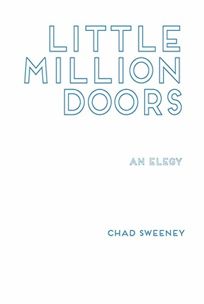by James Benton
FROM: Los Angeles Review
 Like a hurricane of images, or a tsunami of grief, Sweeny’s lines strain against a background of stability and coherence that barely holds together. The book is an elegy not only because the title tells us so, but because it performs its elegiac ritual without the filter of conventional form or syntactical coherence. If grief is inchoate, the poet asks, what language is sufficient to the duty it is called upon to perform? The answer is a language suddenly released from its duties to inform or to persuade—functions of containment, framing, and interpretation—a non-syntax left to its singular capacity to conjure the ineffable, to bring it into being.
Like a hurricane of images, or a tsunami of grief, Sweeny’s lines strain against a background of stability and coherence that barely holds together. The book is an elegy not only because the title tells us so, but because it performs its elegiac ritual without the filter of conventional form or syntactical coherence. If grief is inchoate, the poet asks, what language is sufficient to the duty it is called upon to perform? The answer is a language suddenly released from its duties to inform or to persuade—functions of containment, framing, and interpretation—a non-syntax left to its singular capacity to conjure the ineffable, to bring it into being.
This is not hyperbole. What this book does is how it does it; the message is its method. There seems to be little advantage in trying to force conventional meaning in the sense of narrative arc or the capture of an insight through lyrical flourishes. It is not what Ferlinghetti might call a “workshop poem.” Instead, it creates an entirely new language of grief and recovery that at once recognizes the stable ground of being on which it had once existed while exploding into a new universe of fracture, compression, and transformation. Consider this moment (for what else can we call it):
My clothes grew tired an
End of day I begged thisAir to
Hundred meAs many genders
As beesIn the lavender field my
Lovely heroWhat nothing like sleep did the water
Where have youGone little murder find me here
The book-length poem is set almost entirely in couplets, though that form is broken at irregular intervals. The first word in each line is capitalized, a long abandoned poetic tradition among contemporary writers; it is a practice that stands out in contrast to the absence of any other markers of “standard written English,” creating considerable cognitive tension. The tension is compounded by what James Longenbach calls annotated line endings, endings that crosscut standard syntactical units and disrupt what we think of as the normal flow of thought. Since we cannot decode the syntax in the normal way, we must constantly reassess what we are reading, just as the speaker constantly and urgently reassesses their decentered reality.
And there is a speaker of the poem. A speaker chanting a dissociated glossolalia. Nouns functions as verbs, objects transform into subjects, lines shift their center of gravity without warning:
My life without me in it at the center
Of no center is a flower
The first of these two lines could be read as a coherent syntactical unit: “My life without me in it at the center” except for the line that follows, which by itself is not a coherent syntactical unit. We back up, capture the phrase “at the center,” give it a different grammatical function to perform, and complete the second line. This pivot of grammar enacts the rush of thoughts and emotions that happen during an emotional breakdown. The speaker does not tell us they have had a breakdown, does not interpret the breakdown, does not make an argument about cause and effect. We simply experience the breakdown on its own terms.
To read these lines on the page is one thing; to hear them read aloud is quite another. Try it: you quickly fall into a cadence similar to that of a preacher intoning from the pulpit. The sound begins to resemble the effect of Whitman’s long lines of exaltation or that of Ginsberg’s long lines of rage. While at first the chain of images does not appear to make sense, you begin to understand the nonce language and take it as it comes. Toward the end of the book, however, the language begins to coalesce, the fracture becomes less disorienting:
A boy was measuring the day
He had a big hoopThe sun emptied its arrows
Into him
He though the hoop invisible
The language seems to come out the other side, but not completely; the speaker seems to come out the other side of their grief, but not completely. The speaker is transformed; the reader is transformed. Little Million Doors is a tour de force performance.
